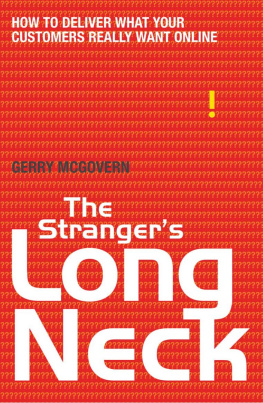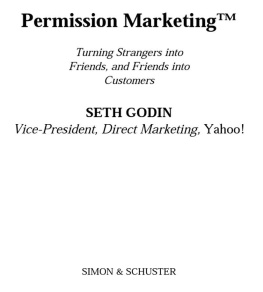
The Strangers Long Neck
The Strangers Long Neck
How to Deliver What Your Customers Really Want Online
Gerry McGovern
A & C Black London
First published in Great Britain 2010
This electronic edition published 2010 by A & C Black Publishers Ltd
A & C Black Publishers Ltd, 36 Soho Square, London W1D 3QY
www.acblack.com
Copyright Gerry McGovern, 2010
The right of Gerry McGovern to be identified as the author of this work has been asserted by him in accordance with the Copyright, Designs and Patents Act 1988.
All rights reserved. You may not copy, distribute, transmit, reproduce or otherwise make available this publication (or any part of it) in any form, or by any means (including without limitation electronic, digital, optical, mechanical, photocopying, printing, recording or otherwise), without the prior written permission of the publisher. Any person who does any unauthorised act in relation to this publication may be liable to criminal prosecution and civil claims for damages.
No responsibility for loss caused to any individual or organisation acting or refraining from action as a result of the material in this publication can be accepted by A & C Black Publishers Ltd or the authors.
A CIP catalogue record for this book is available from the British Library.
Print ISBN: 9-781-4081-1442-1
Electronic ISBN: 9-781-4081-3429-0
Visit www.acblack.com to find out more about our authors and their books.
You will find extracts, authors interviews, author events and you can sign up for newsletters to be the first to hear about our latest releases and special offers.
Contents
This book would not be possible without the support and collaboration of a wide range of people and organizations. I have been lucky to work with a lot of great people over the years.
Firstly, Id like to thank those who generously gave of their time and expertise to read and comment on early drafts, including Fredrik Wack, Gord Hopkins, Eirik Rnjum, Ove Dalen, and Scott Smith. They managed to identify problems and the book is significantly improved because of their input.
Much of this book is based on my experience working with a wide variety of organizations. Id particularly like to thank Microsoft. Although I live in Dublin I have so much interaction with Microsoft that sometimes I feel like I live in Seattle. Ive learned a lot from Microsoft and would particularly like to thank Suzanne Sowinska, Alex Blanton, Peter Horsman, Laurel Hale, Meyyammai Subramanian, Katherine Inman, and Jason Kozleski.
Another organization that requires special thanks is Tetra Pak who has been extremely generous to me over the years. Id particularly like to thank Jenny Almstrom who always brings great enthusiasm and energy to her work. Gabriel Olsson deserves special mention too, and I owe my sincere thanks to Nancy Helledie and Jrgen Haglind for kindly approving the Tetra Pak case study.
I would also like to thank Enterprise Ireland, Scottish Enterprise, Innovation Norway, NHS Choices, Cisco, and OECD (thanks Cynthia!).
Id like to thank Alison OByrne for proofreading the manuscript, and also my son Aonghus for his excellent editing and general research help.
There are many, many inspiring figures out there when it comes to putting the customer at the center of the web universe, but here are a few that have particularly inspired me over the years: Jared Spool, Jakob Nielsen, and Seth Godin.
chapter 1
_______________________________________
Trading with strangers
If life is a competitive struggle, why is there so much cooperation about? And why, in particular, are people such eager cooperatorsThe thing that needs explaining about human beings is not their frequent vice, but their occasional virtue.
Matt Ridley
DESIGNING WEB SITES FOR STRANGERS
The man who had suddenly appeared at the top of the hill was a stranger. Right below him, and carrying a dead boar between them, were three men who had hunted in this area since childhood. Fear flicked across the strangers face. His nostrils flared as he sucked in more air; his eyes widened, and the landscape became larger before him. The three men dropped the boar and raised their weapons.
They stood there, staring at each other. The stranger tried his best to smile. Two of the men glanced at their leader for a sign. Then the sun came out. The chain of colorful stones the stranger was wearing around his neck glistened and sparkled.
If theres one reason more than any other that Web sites fail, its because the web teams managing them lack understanding of, and empathy for, their customers.
The leaders eyes focused on the stones and he now wore an inquisitive expression. He had never seen such beautiful stones before. Then something amazing happened. Instead of killing the stranger and taking his colorful stones, he decided to trade. He would offer the hungry stranger some of his boar in exchange for those fantastic stones.
Somewhere in the not too distant past, trade between strangers began. The old way had been fight or flight. If you saw strangers, you either ran from them or tried to kill them. Once we learned to trade with strangers, our world jumped on a rollercoaster of change and progress. We ventured beyond our tight-knit families and tribes to build cities and civilizations. We moved from isolated villages to the global village, and to the World Wide Web.
If theres one reason more than any other that Web sites fail, its because the web teams managing them lack understanding of, and empathy for, their customers. The customer is a stranger and this book is about helping you understand your customers so that you can create more intuitive Web sites that are truly easy to use.
The pull of the tribethe organization or departmental unitis great, but it is the single greatest source of Web site failure. This book will give you a range of techniques to avoid that pull and to truly understand and design for the stranger. And it is as much about intranets as it is about public Web sites. Remember, employees are the customers of the intranet.
To live in the modern world is to be surrounded by strangers. To live in the primitive world is to live only with family, the department, the tribe of graphic designers, or content writers. This you must resist, which will be hard because the Web is a cold place. Its not like running a shop or a restaurant or an office. You dont get the normal feedback you would get if you were a manager and walked into your supermarket and saw big queues at the checkouts or unhappy faces.
Real people use your Web site every day. Real people? Yes, real people. Strange as it may seem, thats an incredibly hard thing for most of us involved in Web site management to understand. And out of sight is out of mind. We dont see these people, so in essence they dont exist. That is why Web sites fail. The Web sites that succeed get constant feedback from their customers as they seek to complete tasks on the Web site.
This book gives you methods to get that feedback in the form of defensible management metrics. Over a 15-year period, the ideas have been developed within some of the worlds largest organizations, including Microsoft, Tetra Pak, Rolls-Royce, Schlumberger, IKEA, Cisco, and OECD (Organization for Economic Co-Operation and Development).
The essential underlying method is called task management, which is based on the following principles:
1. Every Web site has a small set of tasks that deliver a huge amount of value. These are the top tasks and they exist in what I call the Long Neck.
Next page












